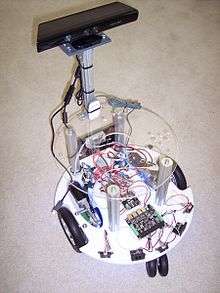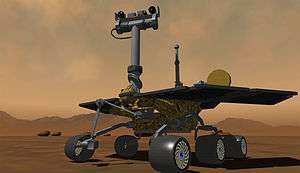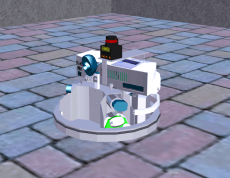Microsoft Robotics Developer Studio
 | |
| Developer(s) | Microsoft in association with the community |
|---|---|
| Initial release | December 18, 2006 |
| Stable release | 4.0 / March 8, 2012 |
| Operating system |
|
| Type | Robotics suite |
| License | Various |
| Website |
www |
Microsoft Robotics Developer Studio (Microsoft RDS, MRDS) is a Windows-based environment for robot control and simulation. It is aimed at academic, hobbyist, and commercial developers and handles a wide variety of robot hardware. It requires the Microsoft Windows 7 operating system.
RDS is based on CCR (Concurrency and Coordination Runtime): a .NET-based concurrent library implementation for managing asynchronous parallel tasks. This technique involves using message-passing and a lightweight services-oriented runtime, DSS (Decentralized Software Services), which allows the orchestration of multiple services to achieve complex behaviors.
Features include: a visual programming tool, Microsoft Visual Programming Language for creating and debugging robot applications, web-based and windows-based interfaces, 3D simulation (including hardware acceleration), easy access to a robot's sensors and actuators. The primary programming language is C#.
Microsoft Robotics Developer Studio includes support for packages to add other services to the suite. Those currently available include Soccer Simulation and Sumo Competition by Microsoft, and a community-developed Maze Simulator, a program to create worlds with walls that can be explored by a virtual robot, and a set of services for OpenCV. Most of the additional packages are hosted on CodePlex (search for Robotics Studio). Course materials are also available.
Components

There are four main components in RDS:
- CCR (Concurrency and Coordination Runtime)
- DSS (Decentralized Software Services)
- VPL (Visual Programming Language)
- VSE (Visual Simulation Environment)
CCR and DSS are also available separately for use in commercial applications that require a high level of concurrency and/or must be distributed across multiple nodes in a network. This package is called the CCR and DSS Toolkit.
Tools

The tools that allow to develop an MRDS application contain a graphical environment (Microsoft Visual Programming Language : VPL) command line tools allow you to deal with Visual Studio projects (VS Express version is enough) in C#, and 3D simulation tools.
- Visual Programming Language is a graphical development environment that uses a service and activity catalog.
- They can interact graphically, a service or an activity is represented by a block that has inputs and outputs that just need to be dragged from the catalog to the diagram.
- Linking can be done with the mouse, it allows you to define if signals are simultaneous or not, permits you to perform operations on transmitted values...
- VPL also allows you to generate the code of new "macro" services from diagrams created by users.
- It is possible in VPL to easily customize services for different hardware elements.
- RDS 3D simulation environment allows you to simulate the behavior of robots in a virtual world using NVIDIA PhysX technology (3D engine originally written by Ageia) that includes advanced physics.

- There are several simulation environments in RDS. These environments were developed by SimplySim
- Apartment
- Factory
- Modern House
- Outdoor
- Urban
- Many examples and tutorials are available for the different tools, which permits a fast understanding of MRDS. Several applications have been added to the suite, such as Maze Simulator, or Soccer Simulation which is developed by Microsoft.
- The Kinect sensor can be used on a robot in the RDS environment. RDS also includes a simulated Kinect sensor. The Kinect Services for RDS are licensed for both commercial and non-commercial use. They depend on the Kinect for Windows SDK.
Notable applications
- Princeton University's DARPA Urban Grand Challenge autonomous car entry was programmed with MRDS.[1]
- MySpace uses MRDS's parallel computing foundation libraries, CCR and DSS, for a non-robotic application in the back end of their site.[2]
- Indiana University uses MRDS in a non-robotic application to coordinate a high-performance computing network.[2]
- In 2008 Microsoft launched a simulated robotics competition named RoboChamps using MRDS, four challenges were available : maze, sumo, urban, and Mars rover. the simulated environment and robots used by the competition were created by SimplySim and the competition was sponsored by KIA Motors
- The 2009 robotics and algorithm section of the Imagine Cup software competition uses MRDS visual simulation environment. The challenges of this competition were also developed by SimplySim and are improved versions of the RoboChamps challenges.
Critique
- The complication and overhead required to run MRDS prompted Princeton Autonomous Vehicle Engineering to convert their Prospect 12 system from MRDS to IPC++.[3]
- The main RDS4 website hasn't been updated since 6/29/2012.
Versions and Licensing
- Robotics Studio 1.0 (Commercial and Non-Commercial Use Licenses) -- Release Date: December 18, 2006
- Robotics Studio 1.5 (Commercial and Non-Commercial Use Licenses) -- Release Date: May 2007
- Robotics Studio 1.5 'Refresh' (Commercial and Non-Commercial Use Licenses) -- Release Date: December 13, 2007
- Robotics Developer Studio 2008 Standard Edition (Commercial Use), Academic Edition (Academic use) and Express Edition (Commercial and Non-Commercial Use) -- Release Date: November 18, 2008
- Robotics Developer Studio 2008 R2 Standard Edition (Commercial Use), Academic Edition (Academic use) and Express Edition (Commercial and Non-Commercial Use) -- Release Date: June 17, 2009
- Robotics Developer Studio 2008 R3—Release Date: May 20, 2010. With R3, Robotics Developer Studio 2008 is now free and the functionality of all editions and CCR & DSS Toolkit has been combined into the single free edition. R3 is no longer compatible with .NET Compact Framework development and it no longer supports Windows CE.[4]
- Robotics Developer Studio 4 -- Release Date: March 8, 2012. This release adds full support for the Kinect sensor via the Kinect for Windows SDK V1. A Reference Platform Design is included in the documentation, with the first implementation being the Eddie robot from Parallax. It also updates RDS to .NET 4.0 and XNA 4.0.[5]
Supported robots


- ABB Group Robotics - ABB Connect for Microsoft Robotics Developer Studio
- Adept MobileRobots Pioneers (first robots to run under MRDS) Pioneer DX and Pioneer AT Official WebSite (Subsumed under reference design)
- Aldebaran Robotics Nao Official WebSite (Support dropped in latest version)
- Arieh Robotics Project Junior (Physical computing PC) Official WebSite
- CoroWare CoroBot and Explorer Official Website
- Lego Mindstorms NXT Official Website
- Lego Mindstorms RCX (Support dropped in Robotics Developer Studio 2008)
- iRobot Create
- KUKA Robotics Educational Framework
- Parallax Boe-Bot
- Parallax Scribbler. Through IPRE.
- Parallax Eddie robot. Supported directly by software available for download from Parallax.
- fischertechnik FT16 (Supported through MRDS Codeplex Samples)
- Robosoft's robots Official WebSite
- Kondo KHR-1 (Supported through MRDS Codeplex Samples)
- Segway RMP Official WebSite by: Ben Axelrod
- Surveyor SRV-1
- RoboticsConnection Traxster. Link
- RoombaDevTools by RoboDynamics
- uBot-5 from the Laboratory For Perceptual Robotics at University of Massachusetts Amherst
- Vex Robotics Design System available at CodePlex
- WowWee RoboSapien, via the USB-UIRT device
- ZMP INC. e-nuvo WALK Official Website
- CNRobot Co. Ltd CRX10 Official Website
- Robotino from Festo Didactic Germany
Microsoft Robotics and the Future
Microsoft Robotics Developer Studio has not been updated or patched since version 4.0, which was released on March 8th, 2012. On September 22nd, 2014, as part of Microsoft's restructuring plan, the Robotics division of Microsoft Research was suspended, according to a tweet from Ashley Feniello, the then-current head of the division. It is now highly unlikely that MRDS will ever be updated again, however forum members (MVPs) may still offer limited support.[6]
See also
- Player Project – used in research and post-secondary education (open source and free)
- Webots
- Concurrency and Coordination Runtime
- URBI
- Robotic mapping
- Robot software
- Mobile Robot Programming Toolkit
- Arduino
- Robot Operating System
References
- ↑ Technical Paper for the Darpa Challenge
- 1 2 SDTimes On The Web, Microsoft's shift to parallel computing, By David Worthington, August 1, 2008
- ↑ Princeton Autonomous Vehicle Engineering -Section Software
- ↑ Microsoft Announces Robotics Developer Studio 2008 R3: Microsoft Robotics Blog
- ↑ Microsoft Announces Robotics Developer Studio 4 Beta: Microsoft Robotics Blog
- ↑ Feniello, Ashley (20 Sep 2014). "Sadly, the Microsoft robotics team has been shut down. My card key stops working tomorrow afternoon... :-/". Twitter. Retrieved 2016-01-20.
Morgan, Sarah (2008). Programming Microsoft Robotics Studio. Microsoft Press. ISBN 0-7356-2432-1.
Johns, Kyle; Taylor, Trevor (2008). Professional Microsoft Robotics Developer Studio. John Wiley & Sons. ISBN 0-470-14107-7.
Kang, Shih-Chung; Chang, Wei-Tze; Gu, Kai-Yuan; Chi, Hung-Lin (2011). Robot Development Using Microsoft Robotics Developer Studio. Chapman and Hall/CRC Press. ISBN 978-1-4398-2165-7.
External links
- Official website
- Microsoft MSDN robotics pages
- Microsoft Robotics Studio: An Introduction
- Microsoft Robotics Studio Runtime – An Introduction
- MRDS Codeplex Samples (MRDS 2008 R3)
- Additional Samples from Professional Robotics Developer Studio textbook (MRDS 2008 R3)
- Microsoft Robotics Studio Community - Turkey
- Microsoft robotics newsgroup from Google Groups
- Channel9 wiki page about Microsoft Robotics Studio
- www.Conscious-Robots.com pages for MSRS (Microsoft Robotics Studio)
- PhysX by Ageia Home
- Robubox's MSRS tutorials and simulator samples Official Website
- SimplySim : MRDS 3D simulation company
- Imagine Cup 2009 : Robotics & Algorithm
- https://twitter.com/AshleyFen/status/5133923914670489600
| ||||||||||||||||||||||||||||||||||||||||||||||||||||